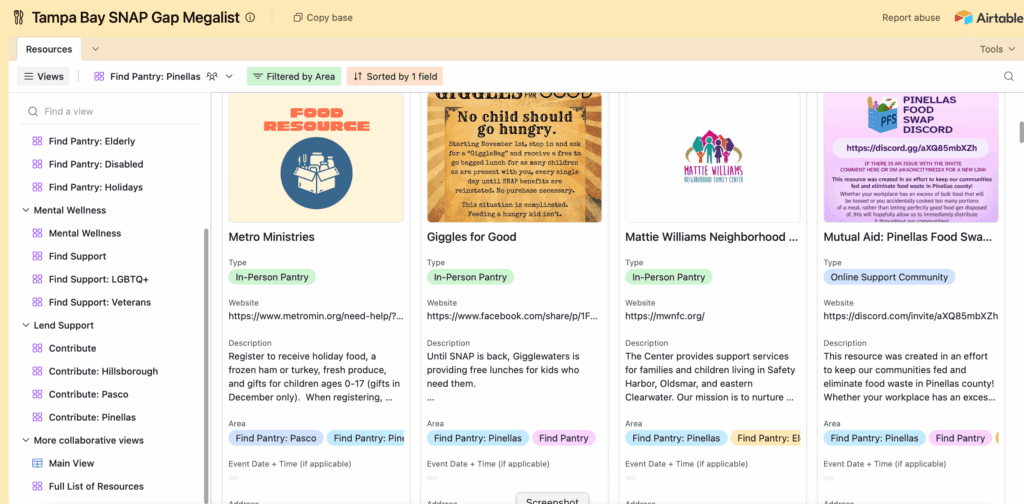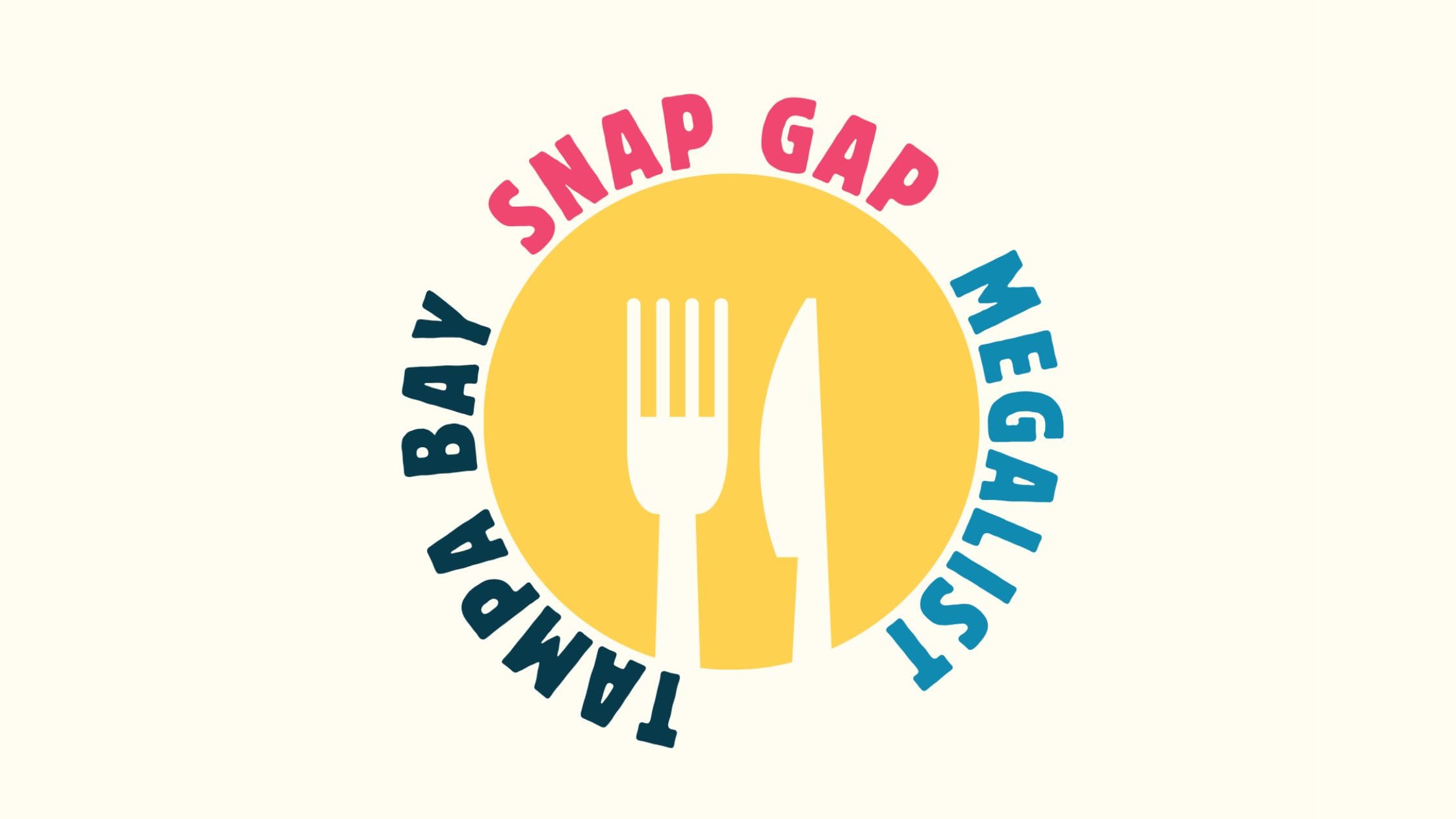Tampa Mom Launches Tampa Bay SNAP Gap Megalist to Help Local Families in Need
Safety nets. They are the core of what millions of American families rely on each day to get by. And now there's the very real possibility that one of the biggest safety nets, the supplemental food assistance program, SNAP, will slip away come November 1st if the government shutdown lingers on.
But Tampa mom, Kas Miller, is hoping to help keep bellies full by bridging the gap with the launch of the Tampa Bay SNAP Gap Megalist. The online list is updated in real-time and connects families to resources for food and even mental health. It also helps those who want to help find organizations that need it.
I first met Kas eight years ago, when our oldest kiddos were in kindergarten together, and her commitment to this community as a child advocate, along with her background in the nonprofit world, continues to inspire me to this day. We connected once again to help share this new resource with the community and to learn more about why she is dedicating her time to ensure no one has to worry about where their next meal will come from.
Kas–what exactly is the Tampa Bay SNAP Gap Megalist?
KM: The Tampa Bay SNAP Gap Megalist is a community-supported directory of food, mental health, and mutual aid resources across Tampa Bay. It was created in response to the pause on SNAP benefits to make it easier for people to find free meals, pantries, donation drives, and wellness support all in one place.
It’s updated in real time through community submissions, so it grows as neighbors share new resources.
Why did you decide to put this resource together for the community?
KM: When I heard SNAP benefits were being paused, my heart immediately went out to the 250,000+ people in Tampa Bay who count on them to get by. While I’m deeply disappointed by the failure to agree on extending SNAP benefits – a program that ensures people can meet one of the most basic human needs – I’ve been so heartened to see our community come together.
Small businesses, faith-based organizations, neighbors, and school communities are all doing what they can to bridge the SNAP Gap.
I grew up supported by social safety nets, so I know how critical that help can be. I also know how fast our community shows up when systems falter. This project came together out of that. Equal parts resolve and love – to help connect people to food, care, and each other.

How do people use or search the SNAP Gap Megalist?
Anyone can go to tinyurl.com/TBSnapGap to access the SNAP Gap Megalist directly. For more information on how to get involved, share a resource, or get in touch, or access the Megalist, they can go to kasmiller.com.
The resource organized sections for food pantries, free meal programs, and mental health support. Everything is searchable and filterable, so people can find what’s closest to them or meets a specific need. It’s mobile-friendly, too, because sometimes you’re looking for help from a phone.
If there is a nonprofit or pop-up food bank, how can they get added to the list?
KM: It’s simple: there’s a short “Add a Resource” form on the site (kasmiller.com). Anyone can submit information about a pantry, meal site, donation drive, or support program. The submissions go directly into the list for review, and I verify details like hours and contact info before publishing. The goal is to keep it fast, accurate, and community-driven.
How can families support you or these organizations on this list?
KM: There are so many ways to help — donate, volunteer your time, spread the word, or even just share the link on social media so someone who needs it can find it. In addition to resources for folks seeking help, there’s also a “Give Support” section featuring local food drives, donation initiatives, and other efforts that have sprung up in response to the SNAP pause.
It’s a way to make sure all these incredible, fast-moving community efforts are visible in one place so people can plug in easily and help meet the need together
As for the Tampa Bay SNAP Gap Megalist, right now, I especially need volunteers who can help translate resources into Spanish or Haitian Creole, verify pantry information, or share new listings as they appear. A volunteer interest form is available on the website.
How can other communities create something similar?
KM: Start small and start local. You don’t need fancy tools — I built this with the free version of Airtable, a few Google Docs, Canva, and a lot of community input. Most of the resources came from a mix of light Googling and deep dives through Facebook community groups. I’ve also asked friends and neighbors to send anything they spot, and the response has been incredible.
The website is just my name because, honestly, that’s the domain I already had – a leftover from former ambitions of finally building a “real” professional website keeping this project at no-cost. Instead, it turned into this, and I’m glad it did. What matters most is that people can find help when they need it – it’s OK to keep it scrappy, simple, and human.
If another community wants to replicate this, I’m more than happy to share the framework so they can make their own version!
Anything else you want to add?
KM: I have a background in nonprofit organizing and communications, and I’ve worked on disaster relief projects before. I saw how effective a massive, aggregated resource list was in the wake of the Southern California wildfires.
It became the backbone of the community response. I remember watching in real time as people who had extra N95 masks or spare rooms offered them to evacuees on a shared spreadsheet, and others added places where families could get free meals or clean air shelter. It was simple, but it worked: a living document that helped people take care of one another. That spirit stuck with me, and it inspired me to build something similar here.
And honestly, I don’t want to reinvent the wheel: I just want to tell people about the wheel. This is one small thing I can do to help.
I was recently laid off and am more conscious about how I can give, plus I had the time to do it, so I did. When systems fail, we improvise.
This project exists because the people of Tampa Bay showed up with big hearts and even bigger tables. Everyone’s doing what they can to make sure bellies stay full. Even me – trying to save the world, one spreadsheet at a time.
In the end, it’s not about the systems that fall short; it’s about the people who refuse to. The way our community has stepped up to bridge the SNAP gap says everything about who we are – a place where no one should ever wonder if they’ll eat tonight.


